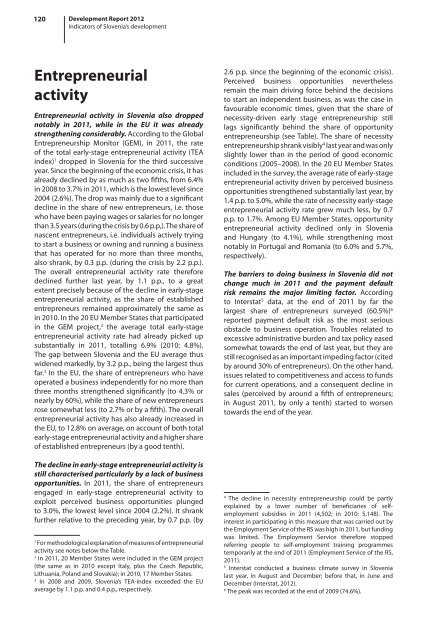development report 2012 - UMAR
development report 2012 - UMAR
development report 2012 - UMAR
Create successful ePaper yourself
Turn your PDF publications into a flip-book with our unique Google optimized e-Paper software.
120 Development Report <strong>2012</strong><br />
Indicators of Slovenia’s <strong>development</strong><br />
Entrepreneurial<br />
activity<br />
Entrepreneurial activity in Slovenia also dropped<br />
notably in 2011, while in the EU it was already<br />
strengthening considerably. According to the Global<br />
Entrepreneurship Monitor (GEM), in 2011, the rate<br />
of the total early-stage entrepreneurial activity (TEA<br />
index) 1 dropped in Slovenia for the third successive<br />
year. Since the beginning of the economic crisis, it has<br />
already declined by as much as two fifths, from 6.4%<br />
in 2008 to 3.7% in 2011, which is the lowest level since<br />
2004 (2.6%). The drop was mainly due to a significant<br />
decline in the share of new entrepreneurs, i.e. those<br />
who have been paying wages or salaries for no longer<br />
than 3.5 years (during the crisis by 0.6 p.p,). The share of<br />
nascent entrepreneurs, i.e. individuals actively trying<br />
to start a business or owning and running a business<br />
that has operated for no more than three months,<br />
also shrank, by 0.3 p.p. (during the crisis by 2.2 p.p.).<br />
The overall entrepreneurial activity rate therefore<br />
declined further last year, by 1.1 p.p., to a great<br />
extent precisely because of the decline in early-stage<br />
entrepreneurial activity, as the share of established<br />
entrepreneurs remained approximately the same as<br />
in 2010. In the 20 EU Member States that participated<br />
in the GEM project, 2 the average total early-stage<br />
entrepreneurial activity rate had already picked up<br />
substantially in 2011, totalling 6.9% (2010: 4.8%).<br />
The gap between Slovenia and the EU average thus<br />
widened markedly, by 3.2 p.p., being the largest thus<br />
far. 3 In the EU, the share of entrepreneurs who have<br />
operated a business independently for no more than<br />
three months strengthened significantly (to 4.3% or<br />
nearly by 60%), while the share of new entrepreneurs<br />
rose somewhat less (to 2.7% or by a fifth). The overall<br />
entrepreneurial activity has also already increased in<br />
the EU, to 12.8% on average, on account of both total<br />
early-stage entrepreneurial activity and a higher share<br />
of established entrepreneurs (by a good tenth).<br />
The decline in early-stage entrepreneurial activity is<br />
still characterised particularly by a lack of business<br />
opportunities. In 2011, the share of entrepreneurs<br />
engaged in early-stage entrepreneurial activity to<br />
exploit perceived business opportunities plunged<br />
to 3.0%, the lowest level since 2004 (2.2%). It shrank<br />
further relative to the preceding year, by 0.7 p.p. (by<br />
1<br />
For methodological explanation of measures of entrepreneurial<br />
activity see notes below the Table.<br />
2<br />
In 2011, 20 Member States were included in the GEM project<br />
(the same as in 2010 except Italy, plus the Czech Republic,<br />
Lithuania, Poland and Slovakia); in 2010, 17 Member States.<br />
3<br />
In 2008 and 2009, Slovenia’s TEA-index exceeded the EU<br />
average by 1.1 p.p. and 0.4 p.p., respectively.<br />
2.6 p.p. since the beginning of the economic crisis).<br />
Perceived business opportunities nevertheless<br />
remain the main driving force behind the decisions<br />
to start an independent business, as was the case in<br />
favourable economic times, given that the share of<br />
necessity-driven early stage entrepreneurship still<br />
lags significantly behind the share of opportunity<br />
entrepreneurship (see Table). The share of necessity<br />
entrepreneurship shrank visibly 4 last year and was only<br />
slightly lower than in the period of good economic<br />
conditions (2005–2008). In the 20 EU Member States<br />
included in the survey, the average rate of early-stage<br />
entrepreneurial activity driven by perceived business<br />
opportunities strengthened substantially last year, by<br />
1.4 p.p. to 5.0%, while the rate of necessity early-stage<br />
entrepreneurial activity rate grew much less, by 0.7<br />
p.p. to 1.7%. Among EU Member States, opportunity<br />
entrepreneurial activity declined only in Slovenia<br />
and Hungary (to 4.1%), while strengthening most<br />
notably in Portugal and Romania (to 6.0% and 5.7%,<br />
respectively).<br />
The barriers to doing business in Slovenia did not<br />
change much in 2011 and the payment default<br />
risk remains the major limiting factor. According<br />
to Interstat 5 data, at the end of 2011 by far the<br />
largest share of entrepreneurs surveyed (60.5%) 6<br />
<strong>report</strong>ed payment default risk as the most serious<br />
obstacle to business operation. Troubles related to<br />
excessive administrative burden and tax policy eased<br />
somewhat towards the end of last year, but they are<br />
still recognised as an important impeding factor (cited<br />
by around 30% of entrepreneurs). On the other hand,<br />
issues related to competitiveness and access to funds<br />
for current operations, and a consequent decline in<br />
sales (perceived by around a fifth of entrepreneurs;<br />
in August 2011, by only a tenth) started to worsen<br />
towards the end of the year.<br />
4<br />
The decline in necessity entrepreneurship could be partly<br />
explained by a lower number of beneficiaries of selfemployment<br />
subsidies in 2011 (4,502; in 2010: 5,148). The<br />
interest in participating in this measure that was carried out by<br />
the Employment Service of the RS was high in 2011, but funding<br />
was limited. The Employment Service therefore stopped<br />
referring people to self-employment training programmes<br />
temporarily at the end of 2011 (Employment Service of the RS,<br />
2011).<br />
5<br />
Interstat conducted a business climate survey in Slovenia<br />
last year, in August and December; before that, in June and<br />
December (Interstat, <strong>2012</strong>).<br />
6<br />
The peak was recorded at the end of 2009 (74.6%).
















